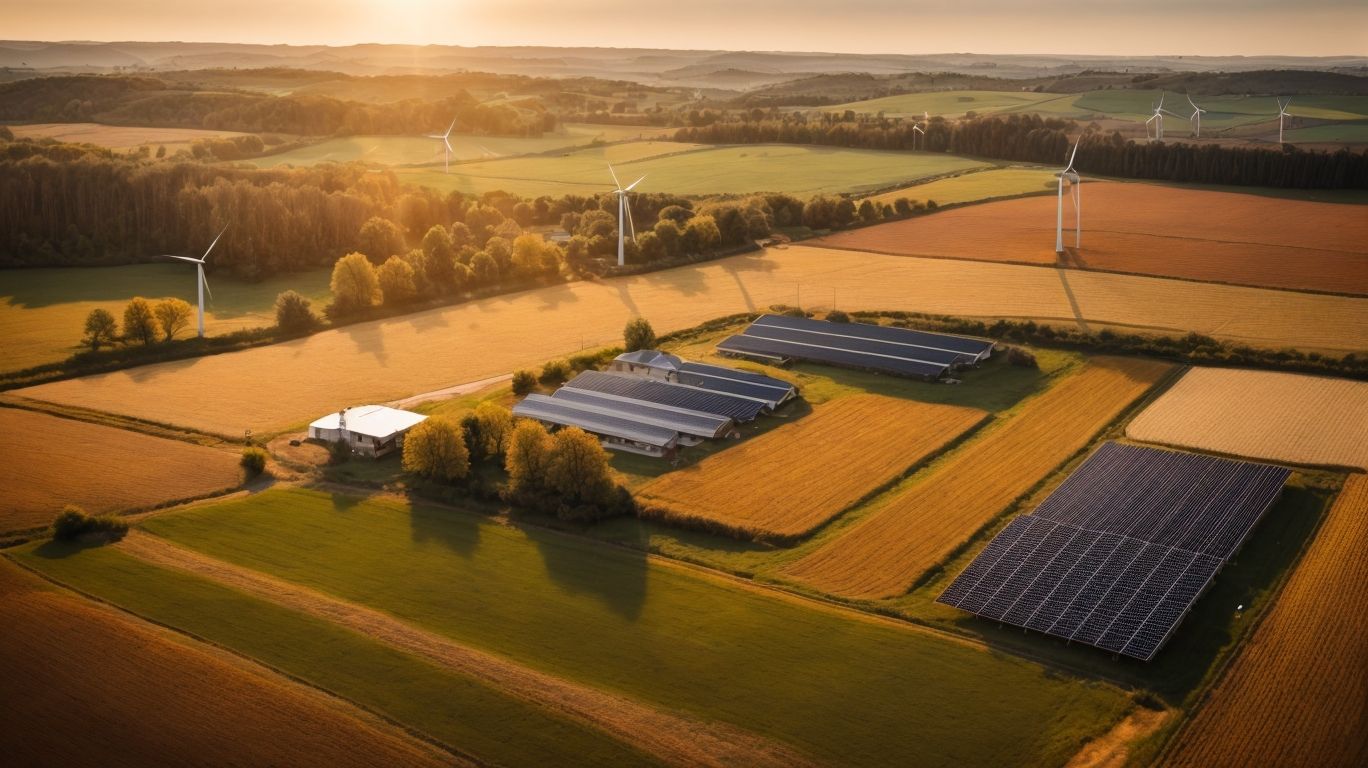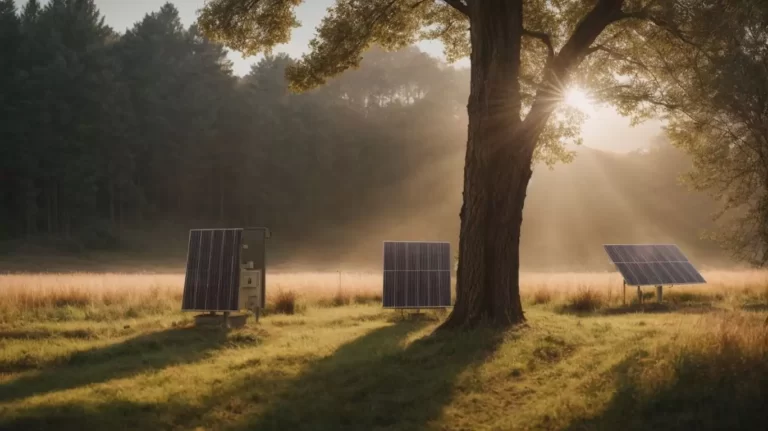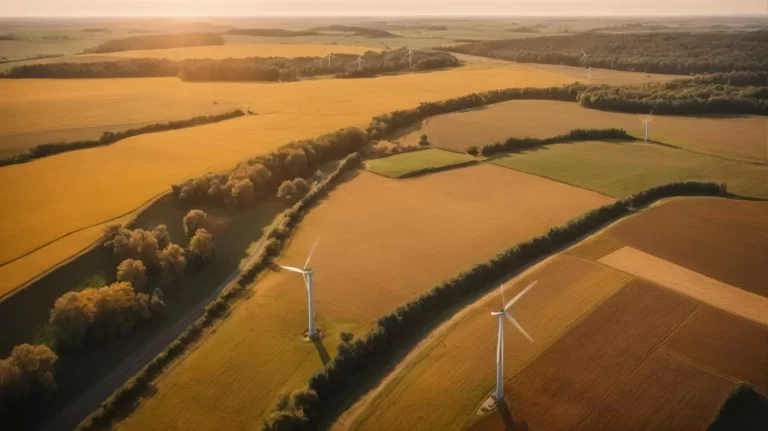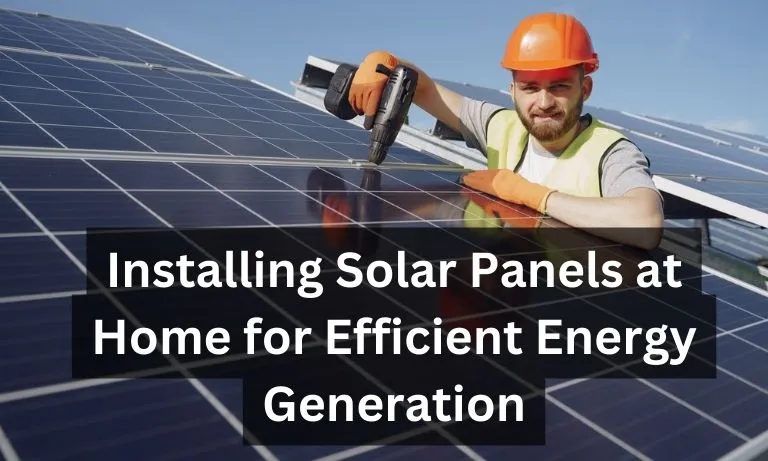Bringing Sustainable Energy to the Countryside: Harnessing Rural Renewables

Welcome to the world of rural renewables, where we explore the potential of sustainable energy in bringing a brighter future to the countryside. In this article, we delve into the importance of this topic in addressing the growing concern of energy insecurity and environmental degradation faced by many rural communities. Are you ready to join the movement towards a greener and more sustainable countryside?
What Are Rural Renewables?
Rural renewables are sustainable energy solutions specifically designed for rural areas. These solutions utilize renewable energy sources such as solar, wind, hydro, and biomass to provide electricity and heat to rural communities.
Renewable energy technologies are well-suited for rural areas due to their scalability and decentralization. They can be implemented on a smaller scale, making them more accessible and cost-effective for rural communities.
Solar power is a popular rural renewable, as it can be easily installed on individual homes or small community buildings. Wind turbines are also commonly used, especially in areas with consistent wind patterns. Hydroelectric power is utilized in regions with access to rivers or streams. Biomass systems convert organic waste into energy, providing a sustainable solution for rural communities.
By adopting rural renewables, communities can reduce their reliance on fossil fuels, lower energy costs, and contribute to a cleaner environment. These renewable energy sources also offer a more reliable and resilient energy supply for rural areas, helping to bridge the energy gap between urban and rural communities.
Why Are Rural Renewables Important?
Sustainable energy sources are becoming increasingly vital in today’s world, and rural areas are no exception. In this section, we will discuss the importance of rural renewables and how they can positively impact both local communities and the environment. From reducing dependence on fossil fuels to promoting economic growth and sustainability, rural renewables bring a multitude of benefits to the countryside. Let’s dive into why these renewable energy sources are crucial for rural areas.
1. Reducing Dependence on Fossil Fuels
To achieve a sustainable future, reducing dependence on fossil fuels is crucial. Rural communities can take the following steps to accomplish this goal:
- Conduct energy audits: Assess current energy consumption patterns and identify areas where fossil fuels can be replaced with renewable alternatives.
- Install solar power systems: Utilize solar panels to generate electricity for homes, businesses, and community facilities.
- Implement wind power projects: Install wind turbines in suitable locations to harness the power of wind and generate clean energy.
- Invest in hydro power: Utilize small-scale hydroelectric systems in rivers or streams to generate renewable energy.
- Promote biomass energy: Utilize organic waste materials, such as agricultural residues or wood, to generate heat or electricity.
- Explore geothermal energy: Tap into the earth’s natural heat to generate electricity or provide heating and cooling solutions.
- Educate and raise awareness: Conduct workshops and campaigns to educate residents about the benefits of renewable energy and encourage their adoption.
- Advocate for policy changes: Engage with local and national authorities to advocate for policies that support renewable energy development and reduce reliance on fossil fuels.
By following these steps, rural communities can significantly reduce their dependence on fossil fuels and transition towards a cleaner and more sustainable energy future.
2. Providing Energy Independence
Providing energy independence in rural areas is crucial for sustainable development and resilience. Here are steps for rural communities to achieve energy independence:
- Evaluate the energy needs and resources of the community.
- Assess the potential for renewable energy sources like solar, wind, hydro, biomass, and geothermal.
- Develop a comprehensive energy plan tailored to the community’s needs and resources.
- Implement renewable energy projects, such as installing solar panels or wind turbines, to generate clean and affordable energy.
- Promote energy efficiency practices, including energy conservation and energy-efficient appliances.
- Explore government incentives and programs that support renewable energy projects in rural areas.
- Encourage community-owned renewable energy projects to foster local investment and engagement.
- Forge partnerships with local businesses and organizations to leverage resources and expertise.
- Ensure awareness and education about the benefits of renewable energy, fostering a supportive community culture.
- Explore creative financing options, such as grants, loans, or crowdfunding, to overcome the high upfront costs of renewable energy projects.
- Cultivate collaborative efforts and support networks within and beyond the community to share experiences and resources.
By following these steps, rural communities can achieve energy independence and contribute to a greener and more sustainable future.
3. Creating Jobs and Economic Growth
Creating jobs and driving economic growth are essential aspects of implementing renewable energy initiatives in rural areas. By following these steps, rural communities can reap the benefits of renewable energy and stimulate job creation and economic development:
- Training and Skills Development: Offer training programs to educate locals on renewable energy technologies and equip them with the necessary skills to participate in the industry.
- Construction and Installation: Utilize local workers for the construction and installation of renewable energy systems, such as solar panels or wind turbines, providing job opportunities during the development phase.
- Operation and Maintenance: Create jobs for maintaining and monitoring renewable energy systems, ensuring their optimal functioning and longevity.
- Manufacturing and Supply Chain: Encourage the establishment of local manufacturing facilities for renewable energy components, promoting regional economic growth and reducing dependence on imports.
- Supporting Industries: Boost local businesses by providing services and support to the renewable energy sector, such as transportation, logistics, and consulting.
By prioritizing these steps, rural communities can harness the potential of renewable energy to not only create jobs but also stimulate economic growth, supporting sustainable development in the countryside.
4. Promoting Environmental Sustainability
Promoting environmental sustainability is a crucial aspect of rural renewables. Communities can take several steps to ensure their renewable energy projects are environmentally friendly:
- Implement energy-efficient practices: Encourage energy conservation and efficiency measures, such as using LED lighting, optimizing insulation, and promoting smart home technologies.
- Invest in clean energy sources: Emphasize the use of renewable energy technologies like solar power, wind power, and hydro power to reduce reliance on fossil fuels and minimize greenhouse gas emissions.
- Preserve natural habitats: Design and construct renewable energy projects in a way that minimizes disruption to local ecosystems and wildlife habitats.
- Adopt sustainable land management practices: Promote responsible land use practices, such as reforestation, erosion control, and sustainable agriculture, to maintain a healthy environment.
- Educate and raise awareness: Conduct community outreach programs to educate residents about the importance of environmental sustainability and encourage sustainable practices in daily life.
Fact: Renewable energy sources produce virtually no air pollutants, helping to improve air quality and reduce the negative impacts of traditional energy sources on human health and the environment.
What Are the Different Types of Rural Renewables?
Rural communities face unique challenges when it comes to accessing sustainable energy sources. However, with the advent of rural renewables, these communities can now harness the power of their surroundings to meet their energy needs. In this section, we will discuss the various types of rural renewables, including solar power, wind power, hydro power, biomass energy, and geothermal energy. Each of these methods offers distinct advantages and can be tailored to fit the specific needs of a rural area. So, let’s dive into the world of rural renewables and discover the ways in which they are transforming the countryside.
1. Solar Power
Solar power is a popular and sustainable form of renewable energy that can be harnessed in rural areas. Here are the steps to implement solar power in rural communities:
- Evaluate solar potential: Assess the amount of sunlight the area receives throughout the year to determine if solar power is a viable option.
- Design solar system: Work with experts to design a solar system that meets the energy needs of the community. Consider factors such as the number of panels, battery storage, and backup power options.
- Secure funding: Explore funding options such as government grants, subsidies, or financing programs specifically designed for renewable energy projects.
- Install solar infrastructure: Hire professionals to install the solar panels, inverters, batteries, and other necessary equipment. Ensure that the installation is done correctly and safely.
- Connect to the grid: If the community is connected to the electrical grid, work with the utility company to establish a connection and arrange for net metering or feed-in tariff agreements.
- Educate the community: Raise awareness about the benefits of solar power and provide information on how community members can optimize their energy usage and reduce their carbon footprint.
- Maintain and monitor the system: Regularly maintain and monitor the solar system to ensure its optimal performance and longevity. Train community members on basic maintenance tasks.
2. Wind Power
Wind power is a crucial component of rural renewables due to its sustainable and abundant nature. To implement wind power in rural communities, follow these steps:
- Conduct a feasibility study to assess the wind resource potential in the area.
- Identify suitable locations for wind turbines, considering factors such as wind speed, land availability, and potential impact on wildlife.
- Obtain the necessary permits and approvals from local authorities and agencies.
- Secure funding for the project through grants, loans, or partnerships with investors.
- Install and connect the wind turbines to the electrical grid, ensuring proper installation and maintenance.
- Establish a power purchase agreement to sell the generated wind energy to utility companies or local consumers.
- Educate and involve the community in the project, fostering support and awareness for wind power.
- Monitor and optimize the wind turbines’ performance to maximize energy production and efficiency.
By following these steps, rural communities can harness the power of wind and contribute to a more sustainable and energy-independent future.
3. Hydro Power
Hydropower is a renewable energy source that harnesses the power of flowing or falling water to generate electricity. It has a rich history that spans thousands of years, with notable examples such as the Ancient Greeks’ use of water wheels to grind grain and pump water. Over time, advancements in technology and engineering have transformed hydropower into a reliable and efficient source of renewable energy. Today, it plays a vital role in powering rural communities, reducing dependence on fossil fuels, and promoting sustainable development.
Here are the steps involved in implementing hydropower:
- Assessment: Conduct a feasibility study to determine the potential of hydropower in the area, considering factors like water availability, flow rate, and elevation drop.
- Site Selection: Identify suitable locations for hydropower installations, considering factors like proximity to water sources, environmental impact, and land availability.
- Permitting: Obtain the necessary permits and approvals from local authorities and regulatory agencies to ensure compliance with environmental and safety regulations.
- Design and Engineering: Develop detailed plans for the hydropower system, including the type of turbine, required infrastructure, and transmission lines.
- Construction: Build the necessary infrastructure, including dams, intake structures, penstocks, turbines, and powerhouses.
- Operation and Maintenance: Regularly inspect and maintain the hydropower system to ensure optimal performance and address any issues promptly.
- Monitoring and Evaluation: Monitor the energy production and environmental impact of the hydropower system to identify areas for improvement and ensure its long-term sustainability.
4. Biomass Energy
Biomass energy is a renewable energy source derived from organic materials such as plants, wood, and agricultural waste. It involves utilizing these materials to generate heat, electricity, or biofuels. Implementing biomass energy in rural communities can provide numerous benefits, including reduced dependence on fossil fuels, job creation, and environmental sustainability.
Here are the steps to implement biomass energy:
- Evaluate the availability of biomass resources in the region.
- Assess the feasibility of implementing biomass energy systems based on local needs and resources.
- Develop partnerships with farmers, foresters, and other local stakeholders to ensure a sustainable supply of biomass feedstock.
- Invest in biomass conversion technologies such as anaerobic digesters, biomass boilers, or gasification systems.
- Establish appropriate infrastructure for storing, transporting, and distributing biomass.
- Educate and train local communities about the benefits and operation of biomass energy systems.
- Secure financing through government incentives, grants, or public-private partnerships.
- Monitor and evaluate the performance of biomass energy systems to optimize efficiency and address any challenges.
Fact: Biomass energy can help reduce greenhouse gas emissions and mitigate climate change, as it releases carbon dioxide during combustion but offsets it by absorbing carbon dioxide during plant growth.
5. Geothermal Energy
Geothermal energy is a sustainable and renewable energy source derived from the heat generated within the Earth. It can be a viable option for rural communities looking to transition to cleaner energy sources. Here are some steps that rural communities can take to implement geothermal energy:
- Assess geothermal potential: Conduct a thorough assessment to determine the geothermal resources available in the area.
- Site selection: Identify suitable locations for geothermal power plants or individual geothermal systems.
- Drilling: Drill wells to tap into the subsurface heat reservoirs and extract the energy from geothermal sources.
- Power generation: Utilize geothermal heat to generate electricity through steam turbines or direct use applications such as heating and cooling.
- Infrastructure development: Establish the necessary infrastructure, such as transmission lines and distribution networks, to distribute the geothermal energy to end-users.
- Community engagement: Involve the local community in the planning and decision-making process to ensure their support and participation.
- Educational programs: Conduct awareness and educational programs to educate the community about the benefits and importance of geothermal energy.
By following these steps, rural communities can harness the potential of geothermal energy and contribute to a more sustainable and greener future.
How Can Rural Communities Implement Renewable Energy?
Sustainable energy solutions are becoming increasingly important in rural communities, where traditional energy sources may be scarce or expensive. But how exactly can rural areas implement renewable energy? In this section, we will discuss three key methods for bringing sustainable energy to the countryside. These include utilizing government incentives and programs, developing community-owned renewable energy projects, and forming partnerships with local businesses and organizations. With these strategies, rural communities can take a proactive approach towards a more sustainable future.
1. Government Incentives and Programs
Government incentives and programs have played a crucial role in promoting the implementation of rural renewables. To take advantage of these opportunities, rural communities can follow these steps:
- Research and identify available government incentives and programs that support renewable energy projects.
- Understand the eligibility criteria, application process, and deadlines for accessing these incentives and programs.
- Engage with local government officials and representatives to gather information and seek guidance on available incentives and programs.
- Develop a comprehensive project proposal that outlines the benefits and feasibility of the renewable energy project.
- Submit the proposal to the relevant government agencies along with the required documentation and supporting evidence.
- Monitor the progress of the application and follow up with the government agencies to ensure timely processing.
- If approved, work closely with the government agencies to fulfill the requirements and conditions of the selected incentives or programs.
- Regularly communicate and report project updates to the government agencies to maintain transparency and accountability.
Fact: Studies have shown that government incentives and programs can boost renewable energy capacity by up to 25%, making them instrumental in driving the growth of renewable energy.
2. Community-Owned Renewable Energy Projects
Community-owned renewable energy projects play a crucial role in promoting rural renewables. These projects involve local communities collectively owning and developing renewable energy systems for their own benefit. Here are some key points about community-owned renewable energy projects:
- Local control: Community ownership empowers rural communities to have a say in their energy sources and reduces reliance on external energy providers.
- Economic benefits: These projects stimulate local economies by creating jobs, retaining revenue within the community, and reducing energy costs for residents.
- Increased renewable energy adoption: Community ownership increases the likelihood of renewable energy adoption, as it fosters a sense of ownership and pride among community members.
- Collaboration and shared resources: By pooling resources, expertise, and funds, community-owned projects can overcome financial and technical barriers associated with renewable energy implementation.
- Community engagement and education: These projects provide opportunities for community members to learn about renewable energy, fostering awareness and education.
Examples of community-owned renewable energy projects include community solar installations, wind farms, and hydroelectric power plants.
3. Partnerships with Local Businesses and Organizations
To successfully implement rural renewables, partnerships with local businesses and organizations are crucial. These collaborations foster community engagement, resource-sharing, and expertise exchange, ensuring the effective development and operation of renewable energy projects. Here are steps to establish these partnerships:
- Identify potential partners: Research local businesses and organizations with a vested interest in sustainability and renewable energy initiatives. This can include agricultural cooperatives, community centers, schools, or tourism associations.
- Engage in dialogue: Reach out to these potential partners to discuss the benefits of renewable energy for the community and explore areas of mutual interest and collaboration.
- Identify shared objectives: Determine common goals and align renewable energy projects with the needs and priorities of local businesses and organizations.
- Develop collaboration agreements: Create formal agreements outlining the roles, responsibilities, and benefits for each partner involved in the renewable energy project.
- Share resources and expertise: Collaborate on project planning, financing, and implementation, leveraging the unique strengths and resources of each partner.
- Promote community involvement: Engage the local community in the renewable energy project through educational programs, workshops, and information sessions led by the partnership.
- Maintain open communication: Regularly communicate and evaluate the progress of the partnership, addressing any challenges or opportunities that arise.
What Are the Challenges and Solutions for Implementing Rural Renewables?
As the world moves towards sustainable energy sources, it is crucial to ensure that rural communities are not left behind. However, implementing renewable energy in rural areas comes with its own set of challenges. In this section, we will discuss the obstacles faced in bringing sustainable energy to the countryside and the solutions that can help overcome them. From high upfront costs to limited access to technology and resources, we will delve into the key challenges and explore potential solutions such as creative financing options and collaborative efforts with support networks.
1. High Upfront Costs
The significant initial expenses involved in implementing rural renewable energy sources can be a major obstacle for many communities. However, there are strategies that can be employed to overcome this challenge:
- Research funding options: Look into government grants, loans, and subsidies specifically available for renewable energy projects in rural areas.
- Form partnerships: Collaborate with local businesses, organizations, and investors who may be interested in supporting renewable energy initiatives. This can help spread the financial burden.
- Explore crowdfunding: Utilize online platforms to raise funds for your project. Engage with the community and highlight the benefits of renewable energy to encourage contributions.
- Consider leasing or power purchase agreements: Instead of purchasing the equipment outright, explore leasing options or enter into agreements where you can purchase energy from a renewable energy provider at a fixed rate.
- Implement energy efficiency measures: Prioritize energy efficiency improvements before investing in renewable energy. This can help decrease overall energy consumption and reduce the size and cost of the renewable energy system needed.
Pro-tip: Conduct a thorough cost-benefit analysis to determine the long-term savings and environmental benefits of implementing rural renewable energy sources. This can help justify the initial high upfront costs and secure necessary funding.
2. Limited Access to Technology and Resources
Limited access to technology and resources can pose challenges for rural communities seeking to implement renewable energy solutions. However, there are steps that can be taken to overcome these barriers:
- Assess current resources: Determine the available technology and resources within the community.
- Identify funding opportunities: Research grants, loans, and subsidies that can help finance renewable energy projects.
- Seek partnerships: Collaborate with local businesses, organizations, and universities to leverage their expertise and access to technology.
- Invest in training and education: Provide training programs to community members to develop skills in renewable energy installation, maintenance, and operation.
- Advocate for government support: Lobby for policies and incentives that promote rural renewable energy development and provide access to technology and resources.
In a small rural community with limited access to technology and resources, the residents came together to implement renewable energy solutions. They assessed their current resources, identified funding opportunities, and sought partnerships with local businesses. Through training and education, they developed the skills needed to install and maintain renewable energy systems. Their efforts were further supported by government policies and incentives. As a result, the community reduced its dependence on fossil fuels, created jobs, and contributed to environmental sustainability. This success story inspired neighboring communities to follow suit, bringing sustainable energy to the countryside.
3. Lack of Awareness and Education
The lack of awareness and education presents significant challenges in the implementation of rural renewable energy. Many community members may not be fully informed about the benefits and potential of renewable energy sources, which hinders their adoption. Moreover, limited knowledge about the technologies and processes involved may discourage individuals from considering renewable energy options.
To address this issue, it is crucial to have educational initiatives and awareness campaigns. By providing information on the advantages of rural renewable energy, such as reduced energy costs and environmental sustainability, communities can become more open to these solutions. Workshops, seminars, and online resources can be utilized to educate residents about different types of renewable energy, their functioning, and potential applications.
Collaboration with educational institutions, local organizations, and industry experts can further enhance awareness and education efforts. By working together, tailored programs can be developed to meet the specific needs of rural communities. Additionally, partnerships with government agencies can facilitate the dissemination of information and the integration of renewable energy education into school curricula. Overall, increased awareness and education will empower rural communities to adopt and implement renewable energy solutions.
4. Creative Financing Options
Creative financing options play a crucial role in implementing rural renewable energy solutions in areas where upfront costs may be a barrier. By exploring alternative funding methods, communities can overcome financial challenges and accelerate the adoption of sustainable energy solutions. Here are some steps to consider:
- Grants and subsidies: Conduct thorough research and apply for grants and subsidies offered by government agencies or renewable energy organizations to offset initial costs.
- Power Purchase Agreements (PPAs): Enter into agreements with renewable energy developers or companies to install and maintain renewable energy systems in exchange for a fixed rate of electricity over a specified period.
- Crowdfunding: Engage the local community and interested stakeholders through crowdfunding platforms to raise funds for renewable energy projects.
- Green bonds: Explore the option of issuing green bonds to attract investors who are specifically interested in financing sustainable initiatives.
- Energy performance contracts: Partner with energy service companies (ESCOs) that offer energy efficiency and renewable energy solutions in exchange for a share of the energy cost savings achieved.
By utilizing these creative financing options, rural communities can overcome financial barriers and make renewable energy projects more accessible and affordable.
5. Collaborative Efforts and Support Networks
Collaborative efforts and support networks are essential for the successful implementation of rural renewable energy projects. By working together, communities can overcome challenges and achieve sustainable energy solutions. Here are five steps to foster such collaboration and support networks for rural renewables:
- Establish local organizations or cooperatives focused on renewable energy to bring stakeholders together and facilitate collaboration.
- Create partnerships with government agencies, non-profit organizations, and educational institutions to access funding, resources, and expertise.
- Organize community events, workshops, and training programs to raise awareness and educate residents about the benefits of renewable energy.
- Promote knowledge sharing and information exchange among community members through online platforms, forums, and newsletters.
- Form alliances with neighboring communities to share experiences, best practices, and resources.
By fostering collaborative efforts and support networks, rural communities can overcome obstacles and accelerate the adoption of renewable energy. Together, they can create a more sustainable and resilient future for the countryside.






